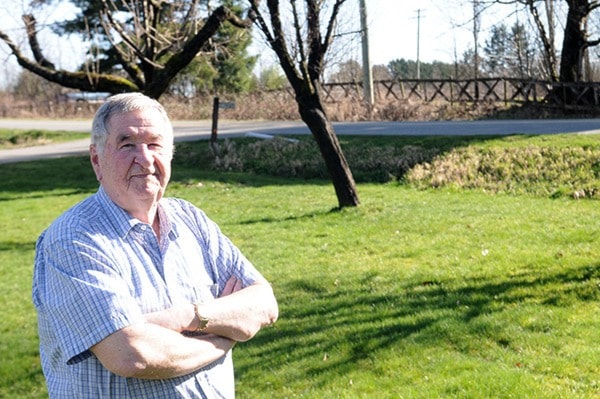Bradner residents are hailing a decision by the Agricultural Land Commission (ALC) to refuse a developer’s request to convert farmland into an industrial park.
The proposed plan – which was forwarded by council to the ALC in 2013 – would have seen 224 acres removed from the Agricultural Land Reserve and used for industrial purposes. The project was adjacent to an existing industrial park on Langley’s eastern edge and included 22 parcels just north of Highway 1 and west of Lefeuvre Road in Bradner.
Developer Ron Emerson had suggested the plan would create 5,000 jobs and billions in economic activity. But the proposal drew opposition from local residents, who said the farmland should remain protected in the Agricultural Land Reserve (ALR). While council voted to forward it to the ALC in 2013, Couns. Patricia Ross and Henry Braun – now the city’s mayor – opposed the plan at the time, with Ross worried about the loss of farmland and Braun saying he didn’t have enough information about costs to service the property.
On Tuesday, Pat Brady, whose family has lived in the area for 80 years and who lives across the road from the proposed development, said he was “more than happy” to hear the project had been rebuffed by the ALC. “There’s still some wise people around in this province,” said Brady, who helped lead opposition to the plan. “Thank goodness for the land commission.”
The proposal generated strong feelings among Bradner residents when it came before council. While some local property owners supported the plan, many others asked council to not forward the proposal to the ALC, citing concerns about traffic and changes to the fabric of the community. A public information meeting drew more than 100 people, and 30 letters opposing the development were forwarded to council.
Others spoke out for the project when it came to council, including local property owners like Brian Sanders, who said at the time: “It just makes so much sense on so many levels.”

The panel suggested that it would rather consider the removal of a large block of properties as part of a “broad planning review” initiated by a local government, rather than at the request of a single developer. The panel noted that in 2005, the ALC excluded 444 acres of land for industrial use as part of Abbotsford’s City in the Country Plan. It said if more industrial land is needed here, the city should be the one leading discussions about the removal of properties from the ALR.
Only a portion of the land in the Bradner proposal is currently used for agricultural purposes, with large portions covered with bush, trees or otherwise not in use. However, the ALC generally considers land potential, rather than current use, in order to discourage speculators from halting agricultural activity in order to gain approval for developing land. The panel said that while a report “suggests some limitations to the agricultural capability of the properties, these limitations do not form the sole basis for exclusion.” The panel said agriculture land in B.C. varies in capability, and that the properties are able to support farming.
Emerson – who did not respond to a request for comment – has another month to appeal the decision. And on Tuesday, Braun told The News that council may need to take a close look at the Bradner lands, as the city continues work on its new Official Community Plan. He noted that the land is also included in the Fraser Valley Regional District’s regional growth strategy as a possible location for industrial development.
At a recent council meeting, it was noted that around half of the industrial lands removed in 2005 have been developed, with rapid development recently expected to soon push that number closer to 70 per cent.
